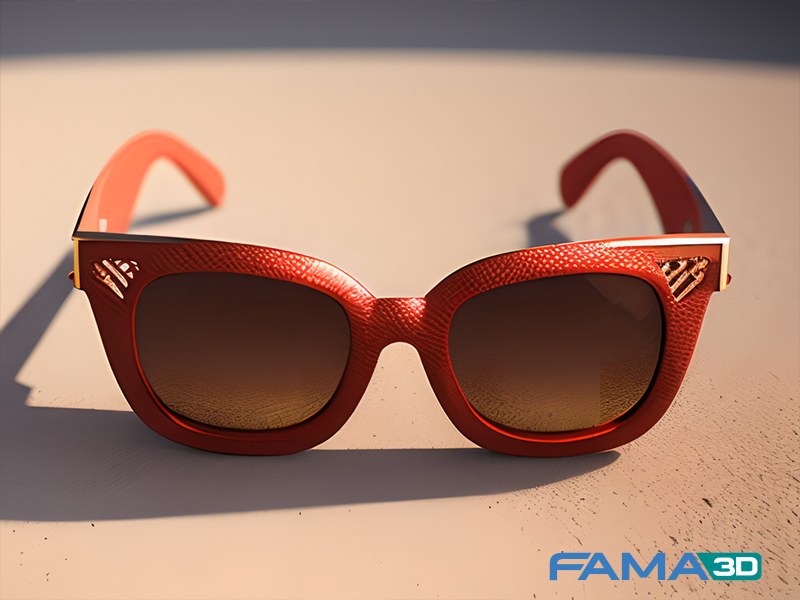3D-Printed Spectacles What is meant by ‘3D-printed spectacles’?
3D printing is an innovative form of spectacles production. This process starts with a designer creating a digital image of the frame using 3D design software. The produced file is then printed using materials such as acetate rollers. The end product is a unique pair of glasses tailor-made for the customer.
Industrial 3D printing makes it possible to create complex shapes and designs that would be difficult or very costly to realise with traditional production methods, such as hand machining or mass printing. In addition, 3D-printed glasses are lighter and more durable than conventional metal or plastic models.
INSTANT 3D PRINTING QUOTE
3D printing technology for spectacles is still in the development phase and is not widely available to consumers. However, some companies already offer this service, which is expected to become more common and cheaper.
Additive 3D printing technology can be used to create customised frames for various uses, from reading to sports; it also allows customised specimens to be made for people with unique face shapes or vision needs. 3D-printed spectacles will also become cheaper than traditional ones over time, as the production mode reduces costs and avoids material waste. Therefore, printing small quantities of customised models is possible, creating limited eyewear lines or special editions.
Why are 3D-printed frames so popular?
3D-printed frames are becoming popular for several reasons. First, 3D printing technology creates a more comprehensive range of shapes and designs, resulting in innovative and increasingly popular styles.
This means eyewear designers can express creativity more freely and offer unique, customised products. Secondly, people who find it challenging to find eyewear that fits their face or meets their specific needs can have access to affordable customised frames.
In addition, 3D-printed glasses are lighter and more durable than traditional metal or plastic glasses, making them more comfortable to wear and longer lasting. All these factors contribute to the growing popularity of 3D-printed frames among consumers and fashion enthusiasts.
How does the 3D printing of spectacles work?
3D-printed spectacles works through rapid prototyping. A designer uses 3D design software to create a digital model of the desired frame, which is then exported in a format compatible with the 3D printer.
The latter uses a filament material, such as acetate or nylon, to create the spectacle frame. The filament is heated until it becomes malleable and then blown through a nozzle, which draws the shape layer by layer. The process takes several hours to complete; the actual time varies depending on the size and design of the product. Once finished, the spectacle frame is cleaned and finished by hand to remove any imperfections and make it ready for use.
3D printed frames are light, solid and fit perfectly
3D printing makes it possible to create precise and complex shapes and designs that would be difficult to achieve with standard production methods or cost significantly more.
This means that 3D-printed spectacles can be designed to fit an individual’s face perfectly, improving the comfort and precision of each pair’s fit.
Most 3D-printed spectacles are made of very light, impact and torsion-resistant materials. They are more comfortable than many average frames, which sometimes have a weight that can be uncomfortable, especially after many hours.
The steps involved in 3D printing specatacles
3D printing of spectacles uses a three-dimensional scanning and facial analysis system to identify the distinctive features of the wearer’s face shape. Through this system, the ideal position of the lenses concerning the eyes can be calculated, and the frame can be designed based on the scanning of each person’s specific facial parameters.
This ensures better vision and the highest level of comfort. In addition, a virtual image processed on the screen allows you to see the aesthetic result of the spectacles on the face in real-time, allowing you to choose from numerous customisation options concerning design, colours, and other details. In this way, everyone meets their stylistic requirements and can assess the final result even before physically printing the model.
How much do 3D-printed spectacles cost?
The cost of 3D-printed specatacles depends on several factors, including the quality of the lenses, the design and the materials used for the frame. In general, 3D printed glasses can be more or less expensive than traditional glasses depending on the level of customisation required and the technology used for 3D printing.
Making a reliable estimate is complex, and manufacturers charge different prices for the same product. Some companies offer affordable 3D-printed glasses in the EUR 100-200 range.
However, the price can also go much higher, depending on the features and lenses used. Some manufacturers offer subscription options for 3D-printed glasses; in these cases, receiving new frames and lenses for a fixed monthly price is possible. The cost of 3D-printed glasses does not depend so much on the material used for the frame but mainly on the entire design and production process.
3D printing requires a significant investment in equipment and software and considerable experience using these technologies. Customising the design and choosing the right lenses for the wearer’s face requires specific analysis and design work.
3D printing demands high precision in creating the model to ensure the final frame perfectly fits the wearer’s face. This involves a considerable amount of time and work on the part of the designers to create a finished product that is aesthetically and functionally perfect. Of course, all this work comes at a cost and, therefore, affects the final price of the 3D-printed glasses.
INSTANT 3D PRINTING QUOTE

